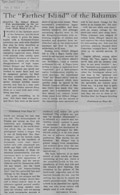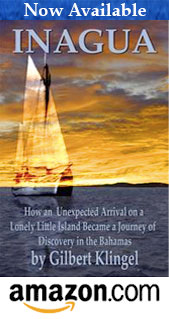The New York Times
Review by Katherine Woods
February 2, 1941
INAGUA is the farthest island of the Bahamas, and the book to which it gives its name begins with a Robinson-Crusoe adventure and ends with chapters that may be truly described as the fact-filled essays of a naturalist. It is an impressively and enjoyably capacious book, whose vivid interest rests chiefly upon. its author’s keenness of observation. But it starts out with the disappointment of high hopes. Gilbert Klingel and Wallie Coleman had planned and saved and worked· to make their boat and its equipment perfect, for their two-man scientific expedition to the West Indies; they had come safely through terrible coastal storms; and then in a near calm the tide and hidden current flung them on a coral reef, and everything was lost.
Not quite everything, to be sure. But their boat was gone; and there they were on the lonely shore of an unknown island. Their naturalist’s observations began when their expedition had been literally smashed. But although succeeding . months were to fill Mr. Klingel’s notebooks with entrancing largesse of oddities and beauties and’ surprises from undisturbed nature, the shipwrecked mariners had first to deal bewilderingly with man.
Seeking help, Gilbert Klingel fell in with a Negro family that aided in salvalge and escorted the strangers to the remote island’s one settlement. And a curious settlement it was. A Negro town falling to decay, a rapacious local “capitalist” and a hard-pressed native Commissioner, nightly revival meetings, the Americans’ “trial” for “Illegal entry,” and extortionate demands which were quickly ended by appeal to the British Colonial officers at Nassau — there was much that was queer and contradictory about this island, the visitors found. Some years later, Gilbert Klingel was to return for the second of the expeditions here narrated and was to see much change for the better in its human life. But now — well, the two white men discovered an empty cottage by the shore and made their camp there.
When Coleman was obliged return home Klingel stayed on and explored the whole island and its surrounding sea: this was his province, scarcely changed since Columbus voyaged here. It must yield up its natural secrets. It did.
Inagua offered, among other things, the “two sights on this· earth that are so unusual that they do not seem credible” : one, the “fantastic and exquisite world of the undersea barrier reef,” the other the flamingoes whose colony here is the “greatest and most magnificent” of the few remaining on this hemisphere. But the spoonbills are roseate creatures, too, “of a hue that is quite unnamable, a living tone that flares and dims with the light”; and they too are so close to extinction that the Inagua breeding flocks are among the last that are left. The hummingbirds of Inagua are unique as they are numerous and charming. The smallest lizard in the world scurries about like an insect (his photograph beside a finger ring is one of thirty-four fine illustrations); and the hermit crabs, living here by the hundreds of thousands, cover their unprotected tails -with abandoned seashells and fight with each other for the possession of these extraneous accoutrements. The sea anemones have a marvelous resilience in their appearance of lovely fragility, and the Sea-urchins do well for themselves without any brains. But the “most gargoylish, yet human looking face” that this naturalist has seen belongs to the Inagua bat.
To the bat; the octopus and the shark Gilbert Klingel shows himself a friend indeed — that is, an advocate against general enmity. Far from· being sinister company for witches, bats are among the most remarkable animals in existence and nearly all quite harmless. The octopus, an animal “of unusual attainments” — is defended in a bizarre and fascinating chapter against -“a mass of calumnies.”; And the Shark, whose species has maintained itself almost unchanged for 400,000,000 years; is in its free ocean life one of nature’s examples of perfection. Most sharks, too, are harmless. Mr. Klingel was in graver danger from mosquitoes, and suffered more from the malignance of the pretty Portuguese man-of-war.
His book, however, is no mere record of such details as these, interesting as they are. There is the essayist’s touch in his contemplation of Wind and tide and the island’s slow building, fine evocation in his picture of the land-crabs’ migration and of the marvels beneath the sea. And his writing has beauty to match his mind’s perceptiveness. This is not a book to be classified too rigidly. Anyone who loves nature will simply read it with delight.



